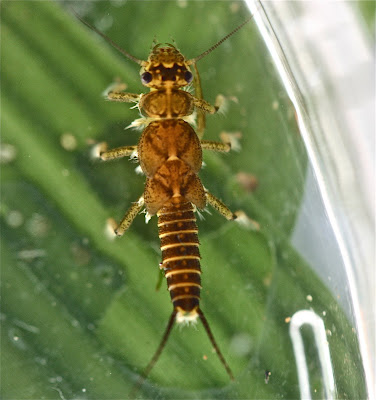Friday, June 10, 2011
Perlesta, Perlesta, Perlesta! First Summer Look at the Rivanna River
I went to Darden Towe Park in Charlottesville today to look for three different things in the main stem of the Rivanna. I only found one of the things I was after: Common stonefly, genus Perlesta. I did not find any damselfly larvae, nor did I find any Leptocerids (Long-horned caddisfly larvae). I'll find them -- we've got all summer to go -- and next week I plan to visit more sites on the Rivanna.
The first time I saw a Perlesta Perlid was last year at the end of May in the Rivanna at Darden Towe. But it did not look like the stonefly nymph in the picture at the top of the page. It looked like this.
This nymph -- as opposed to the Perlesta nymphs I've been finding in Buck Mt. Creek -- is fully mature: note the black wing pads (the edges). Common stoneflies (family Perlidae) -- and I think this is true whatever the genus -- hatch in late June and July: to fly fisherman they're known as the "Golden Stones" (if you look at photos of adults at Troutnut.com you'll understand why). So a lot of the Perlestas I saw today are getting ready to go. But... remember that Perlids take 2-3 years to mature, so we'll continue to see common stoneflies of various sizes throughout the course of the year.
This was probably the dominant taxon that I saw today. I picked up a lot of rocks that were covered with grass (well, vegetation of some sort, that was 3-4" long), looking for Leptocerids which attach their cases to blades of grass and vines. While I didn't see any cases inside the grass, I did see Perlestas -- there must have been 20-30 nymphs on some of the rocks! The other two taxa I saw were common netspinners and midges: it's common to see a lot of both of those in the main stem of the river.
As the photos above indicate, the Perlestas I found did not all look the same. I assume this is a difference of species -- but I don't know that for sure. Three more pictures of these different Perlestas.
The "subanal gills" that we find on Perlestas are pretty clear from the pictures. For the wavy, incomplete row of spinules at the back of the head -- the other feature needed for identification --we need a microscope close-up.
Oh. And I learned a good lesson today. It's difficult to get a good picture at noon in the summer: you can't get out of your shadow!
Subscribe to:
Post Comments (Atom)






No comments:
Post a Comment